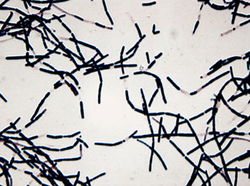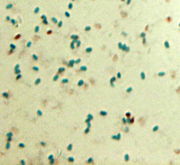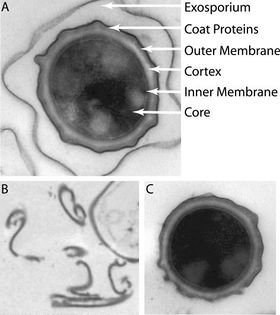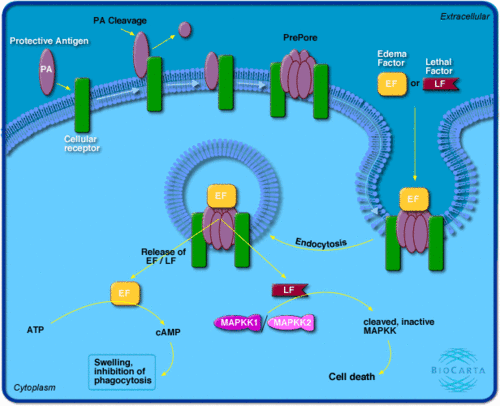The pathogenesis of Bacillus anthracis: Difference between revisions
| Line 19: | Line 19: | ||
==Spore Formation, Anatomy and Germination== | ==Spore Formation, Anatomy and Germination== | ||
[[Image:neww2.jpg|thumb|280px|Right|<b> Figure 3. Transmission Electron Micrograph of <i>Bacillus Anthracis</i> endospore </b>. http://www.ncbi.nlm.nih.gov/pmc/articles/PMC303457/.]] | [[Image:neww2.jpg|thumb|280px|Right|<b> Figure 3. Transmission Electron Micrograph of <i>Bacillus Anthracis</i> endospore </b>. http://www.ncbi.nlm.nih.gov/pmc/articles/PMC303457/.]] | ||
Bacillus anthracis forms one endospore per cell. Its spores form when its non reproductive cells are in need of specific nutrients . The spores are oval in shape and sporulation occurs within 48 hours. | <i>Bacillus anthracis</i> forms one endospore per cell. Its spores form when its non reproductive cells are in need of specific nutrients . The spores are oval in shape and sporulation occurs within 48 hours. | ||
Bacillus anthracis requires oxygen to sporulate. Spores can tolerate heat, cold, dehydration, radiation and even antibacterials (8). The formation of spore commences when cells septate asymmetrically to create a forespore and a mother cell. After septation, the mother cell swallows the forespore and covers it with different layers. The spore is made up of several layers. These layers are the coat, the exosporium and the cortex (Figure 3). The innermost layer is the core. It contains proteins which holds the chromosome. Half of the spore is composed of the spore coat. The flexibility of the spore coat enable the spore to hold the core during germination. It protects the spore from harmful chemicals and aids germination. The cortex containing peptidoglycan protects the spore from radiation, heat and makes the core dry. The exosporium is the outermost layer of the spore. It is a protein rich, balloon-like, loose fitting structure covering a spore(8). The exosporium has been studied to understand the use of anthrax as a weapon. | <i>Bacillus anthracis</i> requires oxygen to sporulate. Spores can tolerate heat, cold, dehydration, radiation and even antibacterials (8). The formation of spore commences when cells septate asymmetrically to create a forespore and a mother cell. After septation, the mother cell swallows the forespore and covers it with different layers. The spore is made up of several layers. These layers are the coat, the exosporium and the cortex (Figure 3). The innermost layer is the core. It contains proteins which holds the chromosome. Half of the spore is composed of the spore coat. The flexibility of the spore coat enable the spore to hold the core during germination. It protects the spore from harmful chemicals and aids germination. The cortex containing peptidoglycan protects the spore from radiation, heat and makes the core dry. The exosporium is the outermost layer of the spore. It is a protein rich, balloon-like, loose fitting structure covering a spore(8). The exosporium has been studied to understand the use of anthrax as a weapon. | ||
The disintegration of the mother cell to produce the spore indicates the completion of spore formation. | The disintegration of the mother cell to produce the spore indicates the completion of spore formation. | ||
The mature spores have a structured arrangement that enables them withstand and endure physical damage and severe environmental conditions. Outside a host, the mature spores of bacillus anthracis are inactive. Upon entry into a host, they have the ability to germinate and become non reproductive cells that can easily replicate all around the host's internal organs.The availability of host’s environment with sufficient nutrients causes germination to occur (17). Non reproductive cells transform back to spores whenever the host dies. Germination and growth of spores in the host cells are essential for the release of its virulence factors. | The mature spores have a structured arrangement that enables them withstand and endure physical damage and severe environmental conditions. Outside a host, the mature spores of <i>bacillus anthracis</i> are inactive. Upon entry into a host, they have the ability to germinate and become non reproductive cells that can easily replicate all around the host's internal organs.The availability of host’s environment with sufficient nutrients causes germination to occur (17). Non reproductive cells transform back to spores whenever the host dies. Germination and growth of spores in the host cells are essential for the release of its virulence factors. | ||
==Pathogenesis and Virulence factors== | ==Pathogenesis and Virulence factors== | ||
Revision as of 20:20, 5 May 2015
Overview

By [Tony Amolo]
Anthrax is an infectious disease caused by the bacteria Bacillus anthracis. Bacillus anthracis is a microorganism from the family Bacillaceae (Figure 1). Unlike other bacillus microorganisms which are harmless saprophytes, bacillus anthracis is an obligate bacillus pathogen in mostly vertebrates. Based on its physical characteristics, bacillus anthracis can be categorized with other microorganisms such as Bacillus cereus, Bacillus thuringiensis and Bacillus mycoides. This classification holds because it is difficult to characterize these organisms based on their 16s rRNA sequences (10). Organisms from the bacillus genus are thermophilic, psychrophilic, acidophilic, alkaliphilic, halotolerant, and halophilic. They have the ability to grow in severe conditions which other microorganisms cannot withstand (4).
Anthrax is as old as man, it was given its name by a Greek physician named Hippocrates because of the black sore it causes on the skin of human and animals(1). It generally affects warm blooded animals including humans. Aloys Pollender, a German physician who was acknowledged for identifying the disease described bacillus anthracis as “chyllus corpuscles” after analyzing the abdomen of infected cows that had died of anthrax (2). Anthrax was broadly studied in the 1870s by Robert Koch and Louis Pasteur. Koch used suspended drop culture methods to trace the complete life cycle of the bacteria and found that the spores formed could remain viable for long period of adverse environments (3).Koch’s studies on Bacillus Anthracis helped him come up with the germ theory of disease.
Cell Structure and Metabolism

Bacillus anthracis is a gram positive, endospore forming bacteria (Figure 2). It is capsulated, immobile and rod shaped. Bacillus anthracis has the ability to make ATP in the presence or absence of oxygen. Bacillus anthracis cannot be seen unless with a microscope. It is 5-6 micrometer in length by 1-1.5micrometer wide and looks like bamboo canes in tissue (13). Despite its small size, the diverse abilities of many species of its genus allows them to survive in different environments (4). They have the ability to form chains, colonies and biofilms.
Habitat and Ecology
Bacillus anthracis is a soil borne bacteria. It lives best in black steppe soils with lots of calcium and at pH levels between (7-9). Endemic anthrax areas have been associated with warmer temperatures, higher soil moisture content and topography (15).
Spore Formation, Anatomy and Germination

Bacillus anthracis forms one endospore per cell. Its spores form when its non reproductive cells are in need of specific nutrients . The spores are oval in shape and sporulation occurs within 48 hours. Bacillus anthracis requires oxygen to sporulate. Spores can tolerate heat, cold, dehydration, radiation and even antibacterials (8). The formation of spore commences when cells septate asymmetrically to create a forespore and a mother cell. After septation, the mother cell swallows the forespore and covers it with different layers. The spore is made up of several layers. These layers are the coat, the exosporium and the cortex (Figure 3). The innermost layer is the core. It contains proteins which holds the chromosome. Half of the spore is composed of the spore coat. The flexibility of the spore coat enable the spore to hold the core during germination. It protects the spore from harmful chemicals and aids germination. The cortex containing peptidoglycan protects the spore from radiation, heat and makes the core dry. The exosporium is the outermost layer of the spore. It is a protein rich, balloon-like, loose fitting structure covering a spore(8). The exosporium has been studied to understand the use of anthrax as a weapon. The disintegration of the mother cell to produce the spore indicates the completion of spore formation. The mature spores have a structured arrangement that enables them withstand and endure physical damage and severe environmental conditions. Outside a host, the mature spores of bacillus anthracis are inactive. Upon entry into a host, they have the ability to germinate and become non reproductive cells that can easily replicate all around the host's internal organs.The availability of host’s environment with sufficient nutrients causes germination to occur (17). Non reproductive cells transform back to spores whenever the host dies. Germination and growth of spores in the host cells are essential for the release of its virulence factors.
Pathogenesis and Virulence factors

Bacillus anthracis contains two toxic plasmids: the pX01, which produces the edema factor, the protective antigen and the lethal factor, and the pX02, which encodes the production of the capsule. Bacillus anthracis expresses it pathogenic action mainly through the capsule and the production of a toxic complex consisting of three proteins(EF, LF and PA). (13) The combination of lethal toxin, which constitutes the protective antigen and the lethal factor and edema toxin which constitutes the protective antigen and the edema factor can induce severe cases of the disease(7). Out the three factors, the protective antigen plays a crucial role in the toxic action of Bacillus anthracis (Figure 4). Protective antigen plays an important role in anthrax poisoning by allowing the connection and entry of the lethal factor and Edema factor into the cytosol. It also sections involved in binding the cell receptor, the lethal factor and the edema factor to the host cell. Protective antigen is a primary antigen that exists in anthrax vaccines(11). The edema factor is a calcium and calmodulin-dependent adenylate cyclase that causes a dramatic increase in cytoplasmic cAMP leading to an imbalance of water homeostasis. The edema toxin may increase host susceptibility to infection by disrupting the cytokine response of monocytes and by suppressing neutrophil functions (11). The lethal factor is a Zn2+ dependent metalloprotease that cleaves major pathways to surface receptors for the transcription of certain genes within the nucleus(12) while the capsule enhances the virulence by inhibiting the phagocytosis of bacillus anthracis.
Transmission and Pathology
Bacillus anthracis is not an invasive organism. The most common ways of transmission of the anthrax disease are through wounds, the pharynx, gastrointestinal tract, the digestive system after ingestion of spore contaminated food or water, skin lesions or abrasions caused by biting flies and the breathing in of dust containing anthrax spores. After transmission through one of these route, the spores of Bacillus anthracis travel to the lymph nodes where they begin to multiply rapidly and the produce spores which germinate to produce the virulence factors (13).
Vaccines and Treatment
Anthrax was the first bacterial disease for which effective preventive treatment (prophylaxis) was developed(11). Prophylaxis played a major role in controlling anthrax in animals and protection to individuals from infection.
Several vaccines has been produced for the anthrax disease. Louis Pasteur is known as the first microbiologist to produce the first anthrax vaccine in 1881 (2). The vaccines were made of spores from weakened genetic variant of Bacillus anthracis. Several vaccines produced to combat the disease include non-living vaccines, In vitro protective antigen, Boor and Tresselt vaccine, production in non-proteinaceous media, UK vaccine, American vaccines(Aerobic antigen and Anaerobic antigen) and Russian antigen (6). Special therapy can also be provided to treat anthrax if it is applied immediately to the infected animal or human. Aside from vaccines, antitoxin and antibiotics have been used to treat the disease. Penicillin is used for treatment of susceptible strains of anthrax, with ciprofloxacin and doxycycline suitable alternatives.(14) Different methods have been adopted to create an enhanced vaccine for humans. The objective is to develop a vaccine that is non reactogenic and involves little administration to perform efficiently (11). However, the difficult aspect of evaluating the efficacy of anthrax vaccine is making an assessment in humans because it is not safe to test it on humans. Animals can be used as a model but the process can be dangerous.
Application to Bioterrorism
Out of many pathogenic bacteria, Bacillus anthracis is one that can be used for bioterrorism. It makes a good model weapon for bioterrorism because it spores can be produced in the lab,last for a long time in the environment and can be found easily in nature. Also because of its small size, it can be placed in food and letters like in 2001 when powdered anthrax was mailed to the U.S postal office. Twenty-two cases of anthrax infections were confirmed. Half of these cases involved cutaneous anthrax and no death resulted. The remaining eleven were identified as inhalational anthrax and produced five deaths. A global awareness should be created to reject the development of such weapons and provide means of developing a vaccine for this deadly disease.
References
1] Annabel Guicharda, Victor Nizetb, c, Ethan Biera "New insights into the biological effects of anthrax toxins: linking cellular to organismal responses." 2012.
2] Joseph A Witkowski,Lawrence Charles Parish "The story of anthrax from antiquity to the present: a biological weapon of nature and humans."2002.
3] George Sternbach "The history of anthrax."2003.
4] Peter C. B. Turnbull "Bacillus."1996.
5] Maxime Schwartz "Dr. Jekyll and Mr. Hyde: A short history of anthrax."2009.
6] Peter Hambleton, J.Anthony Carman, Jack Melling "Anthrax: the disease in relation to vaccines."1984.
7] Mahtab Moayeri, Stephen H Leppla "The roles of anthrax toxin in pathogenesis."2004.
9] W. Beyer, P.C.B. Turnbull. "Anthrax in animals."2009.
10] Les Bailliea, , Timothy D Read. "Bacillus anthracis, a bug with attitude!."2001.
11] Stephen F Little, Bruce E Ivins. "Molecular pathogenesis of Bacillus anthracis infection."1999.
14] Martin Hugh-Jonesa, Jason Blackburn. "The ecology of Bacillus anthracis."2009.
16] [1]
17] Adam Driks. "The Bacillus anthracis spore."2009.
Edited by student of Joan Slonczewski for BIOL 238 Microbiology, 2009, Kenyon College.
